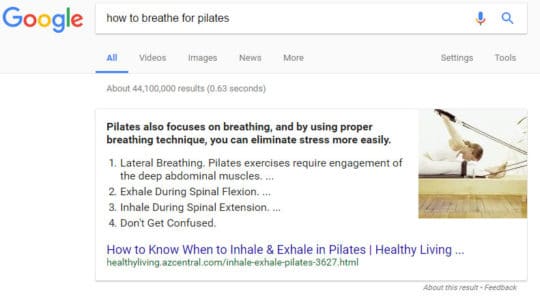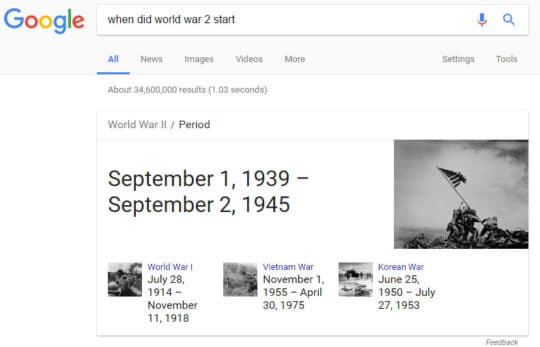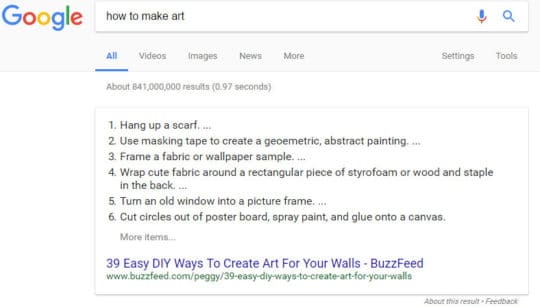When you search Google with a question, it tries to answer it immediately. Try this: write the keywords how to breathe for Pilates in the search engine.
What you see at the top of the result is a snippet. It gives you a definition of the term, practically answering your question straight away, so you don’t even have to visit the page. The point is: if you want to take your search further, that’s the page you’ll probably visit. That’s why you want the pages of your own website to appear in the snippet.
Although the snippet is short, it contains a lot of information about the page in a format you can understand.
When you aim to have your content featured in the SERP snippet (Search Engine Results Page), you want it short, catchy, and on point. With a single glance, the Google user should be able to tell why they need to land on that page. You don’t want sentences cut in the middle, and you need a meta title that catches the user’s eye.
When you see a snippet, you might get the impression that it’s easy to create. You’re wrong. It’s a challenge. You need the best, most relevant content if you want to get featured there. The snippet puts your website in direct competition with all other pages in the results.
Let’s explain everything from the beginning, shall we?
Why do you want your content there?
The answer is simple: more traffic. Google’s major updates, such as Caffeine and Hummingbird, are focused on answering questions with a conversational approach. When you ask Google a question, it may provide a direct answer from its own knowledge base. That happens when you ask “what is radio?” or “when did World War 2 start?”.
If, however, you ask a more unusual question that doesn’t have a direct answer in Google’s knowledge base, the search engine will borrow the answer from a third-party website. That happened with our Pilates question above. Any website can get featured in a snippet as long as it gives a relevant answer.
SearchEngineLand did an experiment and showed that a featured snippet led to a 516% increase in Google organic sessions to the landing page. Is that reason good enough for you?
How to master the art of Google SERP Snippets
Let’s explore the snippet from our example above. It starts with “Pilates also focuses on breathing, and by using proper breathing technique…” When we see the word also, we immediately assume this is part of a more elaborate article. It probably started with a definition of pilates, and some basic explanations before it got to the breathing part.
When we open it, we see we were wrong. It’s a brief article that’s focused on that very question: how to breathe in pilates. It’s not an impressive long-form article with tons of images and practical examples. However, the creators did something right to get featured in the snippet.
So we learn the first rule: create an article that’s focused on a specific question. Let’s see what else we can learn by exploring existing SERP snippets.
1. The keyword ranking is not crucial

HubSpot did a test to see how its pages appeared in Google’s snippets. For the keywords that they ranked #1 in Google’s results, they appeared in the featured snippet 18% of the time. This solves a dilemma: the first result on the list is not always the one featured in the snippet. For the keywords that got HubSpot on rank #5, they appeared in the snippet 28% of the time.
This doesn’t mean you should stop trying to get on the first page of results. Google expects to see relevant keywords and phrases in your title tag. It’s how it judges the relevance of your page to the searcher’s quest.
You should definitely keep that strategy going. However, you should also build backlinks and make the content highly relevant if you want to be good enough for a snippet.
2. The headline is important!

First of all, it should be unique. Identify a common question related to your niche, and form the headline around it. Write an on-point headline that proves you have the answers the audience wants.
Let’s take another example: type how to make art in the search engine. The current snippet shows a Buzzfeed page with this headline: 39 Easy DIY Ways to Create Art for Your Walls.
It works because it’s a listicle, and you know it answers your question.
3. Use the paragraph tag

Google can’t read your entire page to decide what part to feature in the snippet. You need to indicate it! Use the <p> tag to determine your answer to the target question. The answer should be between 54 and 58 words long.
4. Make a list

If you start typing different questions in the search engine, you’ll notice that most of the snippets feature lists. If you go for a what is the question, you’ll probably get a definition instead of a list. However, if you start your query with how chances are – you’ll get a list.
Make a list of brief steps that anyone can understand. When the users click the link, they should see a more elaborate guide. You can position the brief list at the beginning of the article, as an introduction to what follows, or as a summary at the end. Remember: the content has to be great if you want to get it featured there. If necessary, rely on writing companies or freelancers to elevate the quality of your content.
Wrapping Up!

There’s no guarantee that you’ll get your pages featured in Google’s snippets. However, the effort is worth the results. It won’t happen overnight. You’ll need to identify common questions and answer them in the most appropriate way possible. Focus on the users, and you’ll get there! After publishing any content don’t forget to use a snippet checker tool to verify how Google will fetch and display your page in their search result.
This article is written by Robert Morris. He is a digital marketing expert from New York. Now he travels around the world and works freelance for AskPetersen, an essay writing blog. He loves mountain hiking, playing tennis and exploring new countries.








